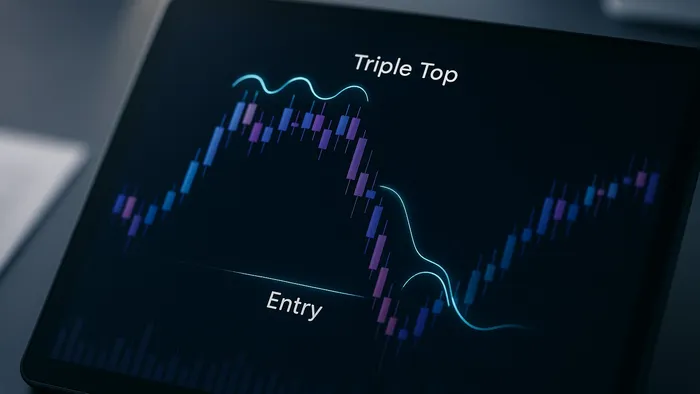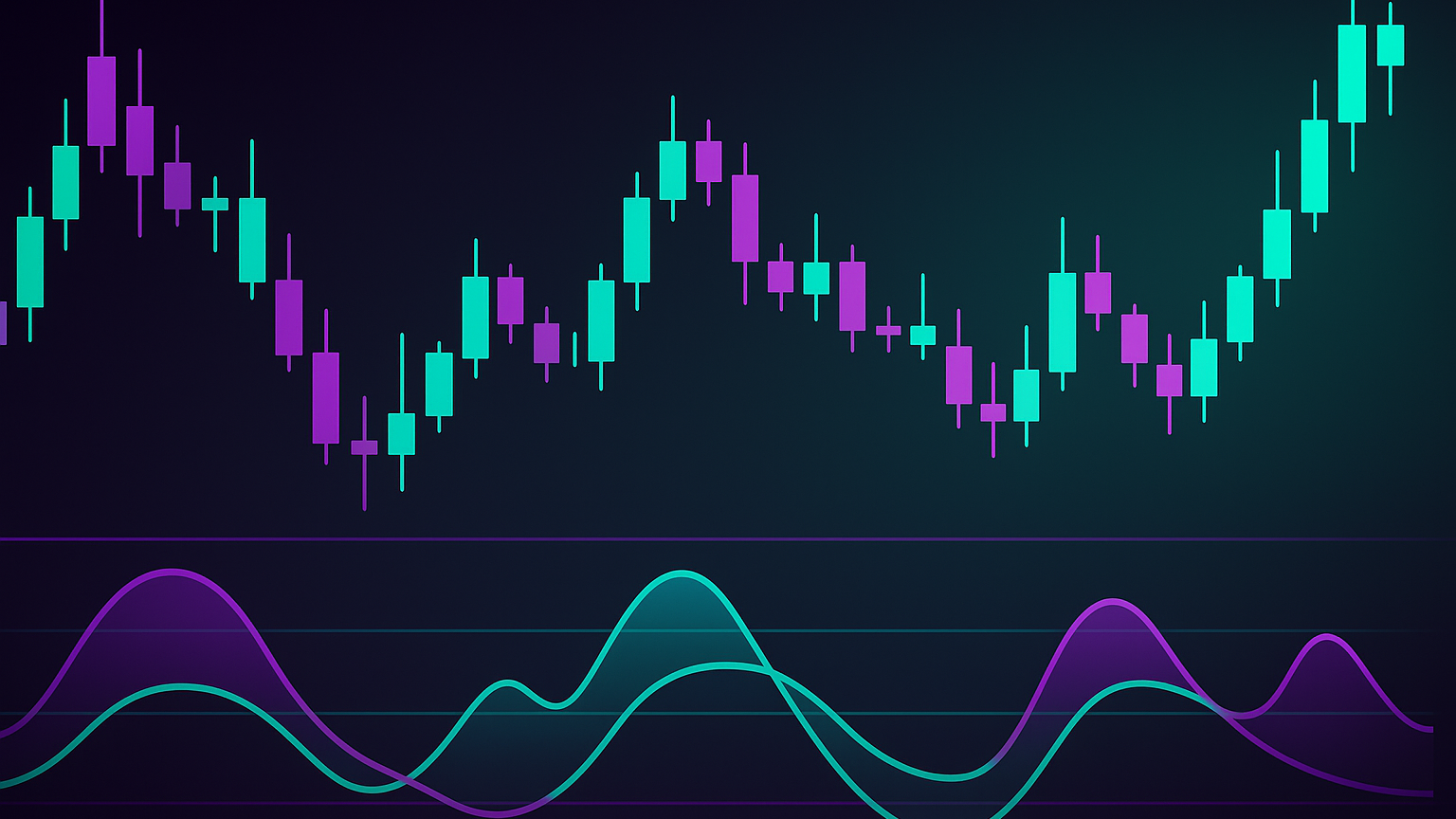Learn how to identify and trade the Triple Top pattern for bearish reversals, including key components, confirmation techniques, and risk management.
The Triple Top pattern is a bearish reversal signal that occurs when an asset hits the same resistance level three times, failing to break through. This signals weakening bullish momentum. Here's how to confirm and trade it:
-
Key Components:
- Three Peaks: Similar highs indicating strong resistance.
- Neckline: Support level formed by two troughs. A break below it confirms the pattern.
- Volume: Declining at each peak, with a surge during the neckline break.
-
Double Confirmation:
- Neckline Breakout: Price closes below the neckline with high volume.
- Retest: Price revisits the neckline (now resistance) with lower volume, confirming the breakout.
-
Indicators for Validation:
- MACD: Shows bearish divergence.
- ADX: Confirms trend strength.
- Stochastic Oscillator: Highlights overbought conditions.
-
Risk Management:
- Set stop-loss 2x ATR above the entry.
- Use the pattern's height to calculate profit targets.
- Limit risk to 1-2% of trading capital per trade.
LuxAlgo’s toolkits and indicators can help identify patterns, confirm signals, and set alerts for better trade execution.
Finding Triple Top Patterns
Pattern Components
A Triple Top pattern is a bearish reversal setup that emerges when prices hit three similar highs, signaling repeated failed attempts by buyers to push past a resistance level. The pattern's key support line, known as the neckline, becomes critical for timing trades, especially when it breaks with a noticeable increase in volume.
| Component | Characteristics | Significance |
|---|---|---|
| Three Peaks | Form at nearly the same price level | Show consistent resistance |
| Two Troughs | Appear at similar levels | Create the neckline (support) |
| Neckline | Acts as horizontal support | Its break signals a reversal |
For example, Tesla (TSLA) rose from $209.39 to $308.63 between May and August 2022, forming three peaks. On September 30, the stock broke below the $265.25 support level, leading to a sharp decline. By December 27, 2022, the price had dropped to $109.10.
Once you've identified these components, it's essential to confirm them with volume trends and momentum shifts.
Volume and Trend Analysis
A strong Triple Top pattern typically shows a decline in volume with each peak, indicating reduced buying interest. When the price breaks below the neckline, a surge in selling volume confirms the reversal.
Here are the key trend elements to watch:
- An uptrend before the pattern forms
- Falling volume with each successive peak
- A sharp increase in volume when the neckline is breached
Momentum indicators, like the MACD or Stochastic Oscillator, can further validate the pattern by highlighting bearish divergence. This happens when momentum weakens even as prices hit similar highs, reinforcing the reversal signal.
A decisive break below the neckline, paired with rising selling volume, is a strong confirmation. Additionally, a failed retest of the neckline can highlight continued selling pressure, offering further trading opportunities.
Understanding these structural and volume dynamics sets the stage for the double confirmation techniques outlined in the following sections.
Double Confirmation Methods
Neckline Breakout Entry
A neckline breakout is a key signal for confirming the Triple Top pattern. It happens when the price clearly drops below the support level formed by the pattern's troughs. To confirm, wait for a daily candle to close below the neckline with noticeably higher-than-average trading volume.
Key features of a neckline breakout include:
- A clear and strong downward price movement
- A significant increase in trading volume accompanying the breakdown
- A bearish candlestick, ideally with a long body and a short upper wick
Neckline Retest Entry
After the initial breakout, prices often revisit the neckline. This retest can provide further confirmation and present a potentially lower-risk entry opportunity. Look for the following signals during the retest:
| Characteristic | Confirmation Signal |
|---|---|
| Volume Profile | Lower trading volume compared to the breakout |
| Price Action | Rejection at the previous support level (now resistance) |
| Candlestick Pattern | Formation of bearish reversal patterns |
"If the volume is lower on these later peaks, it means fewer people are trying to push the price higher, which makes the pattern more likely to be real." - PapersWithBacktest.com
These retest signals provide extra assurance and set the stage for further validation through technical indicators.
Indicator Confirmation
Technical indicators add another layer of validation to the Triple Top pattern. The following indicators are particularly useful:
-
MACD (Moving Average Convergence Divergence)
- Confirms bearish divergence by showing equal price highs paired with declining MACD peaks
- Watch for declining histogram bars, the MACD line crossing below the signal line, and clear divergence between price and MACD
-
ADX (Average Directional Index)
- Measures the strength of the current trend
- A rising ADX during the neckline break indicates increasing bearish momentum
-
Stochastic Oscillator
- Evaluates momentum and potential overbought conditions
- Highlights bearish divergence and slowing momentum as the price nears or breaks the neckline
Using LuxAlgo for Triple Tops
Pattern Detection Tools
LuxAlgo's Price Action Concepts (PAC) toolkit simplifies the process of spotting Triple Top patterns. It scans price movements to identify key elements like:
- Price peaks that are equal or nearly equal
- Support levels that form the neckline
- Volume trends tied to the pattern
- Alignment with overall market structure
Once patterns are detected, you can validate them using backtesting tools.
Strategy Testing
The AI Backtesting Assistant evaluates Triple Top strategies with historical market data. Here's what it offers:
| Testing Component | Features |
|---|---|
| Historical Analysis | Analyze Triple Top strategies over years of market data. |
| Performance Metrics | Measure win rates, profit factors, and maximum drawdowns. |
| Parameter Optimization | Adjust entry and exit criteria for better performance. |
| Risk Assessment | Assess strategy behavior under various market conditions. |
These tools allow you to fine-tune your approach before applying it in real trading.
Trade Alert Setup
With LuxAlgo's alert system, you can receive notifications for both pattern setups and confirmation signals. The system tracks:
-
Pattern Formation Alerts
- Detects peak formations and confirmations
- Monitors volume thresholds
- Tests neckline levels
-
Entry Signal Alerts
- Alerts on neckline breakdowns
- Confirms with volume trends
- Aligns with indicator signals
- Flags relevant price action signals
This alert system works seamlessly with the PAC toolkit, covering everything from pattern detection to trade execution. Plus, traders can customize alerts to fit their strategies and risk preferences.
"If the volume is lower on these later peaks, it means fewer people are trying to push the price higher, which makes the pattern more likely to be real." - PapersWithBacktest.com
Managing Triple Top Trades
Stop-Loss and Targets
To manage risk in Triple Top trades, set clear stop-loss levels and profit targets. For short entries, place your initial stop-loss 2x ATR (Average True Range) above your entry point. Once the trade gains 1 ATR, adjust the stop-loss to breakeven.
For profit targets, measure the vertical distance between the Triple Top peaks and the neckline. Then, project this distance downward from the breakout point to estimate your target (FXOpen).
Finally, determine your trade size to ensure your risk exposure stays within acceptable limits.
Position Size and Risk Ratios
Limit your risk to 1-2% of your trading capital per trade. Use this formula to calculate position size:
Position Size = (Account Risk) / (Trade Risk)
Here’s a quick breakdown of common position sizing strategies:
| Position Sizing Strategy | Best Used In | Key Feature |
|---|---|---|
| Fixed Percentage Risk | Stable market conditions | Adjusts based on account size |
| Volatility-Based | Volatile markets | Relies on ATR for sizing |
| Fixed Dollar Amount | Testing new setups | Keeps risk consistent |
For Triple Top trades, a volatility-based approach works well. It adjusts for market conditions and the pattern's behavior, helping you keep risk consistent.
Once your risk and position size are decided, focus on timing your trade.
Market Rules and Timing
Triple Top patterns often take weeks to fully form, so timing is critical. Use an ATR-based trailing stop to lock in profits while giving the trade room to breathe. A good rule of thumb is to set the trailing stop 1.5 ATR behind the current price.
Monitor pre-market activity before 9:30 AM ET, trade during high-volume hours (9:30 AM–4:00 PM ET), and confirm the pattern with intraday volume analysis. This ensures better accuracy in identifying and executing trades.
Summary
Main Points
The Triple Top pattern indicates a potential bearish reversal when confirmed. Here's what to watch for:
| Component | Key Criteria | How to Validate |
|---|---|---|
| Pattern Formation | Three noticeable peaks at similar resistance levels | Analyze price movements |
| Volume Profile | Rising selling volume at the breakout point | Use volume indicators |
| Double Confirmation | Neckline break paired with other signals | Check multiple technical tools |
| Risk Management | Proper stop-loss placement and position sizing | Apply risk management strategies |
The PAC toolkit from LuxAlgo makes it easier to spot this pattern and provides key confirmation signals during US market hours (9:30 AM–4:00 PM ET).
Next Steps
Use these steps to build your trading strategy:
-
Set Up Pattern Detection
- Configure LuxAlgo tools to detect Triple Top patterns.
- Enable custom alerts for these setups.
- Add overlays for volume analysis.
-
Establish Confirmation Protocol
- Use the Oscillator Matrix to check for momentum divergence.
- Watch volume changes during pattern development.
- Define entry triggers based on a neckline break.
-
Implement Risk Management
- Place stop-loss orders just above the neckline.
- Size positions according to your risk tolerance.
- Set profit targets based on the pattern's height.
"If the volume is lower on these later peaks, it means fewer people are trying to push the price higher, which makes the pattern more likely to be real." - PapersWithBacktest.com
Full Visual Tutorial Of Trading Triple Top Pattern
FAQs
How can I use the Triple Top pattern to spot potential bearish reversals in my trading strategy?
To identify bearish reversals using the Triple Top pattern, start by confirming these key elements:
- An existing upward price trend leading into the pattern.
- Three peaks at nearly the same resistance level, suggesting strong selling pressure.
- Two interim lows forming a clear support level.
- A decisive break below the support line after the third peak, signaling a potential reversal.
Once the pattern is confirmed, monitor volume activity closely. A noticeable increase in volume during the breakdown can strengthen the bearish signal, indicating heightened selling momentum. Combining this with other tools, such as breakout levels or complementary indicators, can further validate your trade entry decision.
How can I confirm a breakout in a Triple Top pattern using volume and other indicators?
To confirm a breakout in a Triple Top pattern, focus on both price action and trading volume. Typically, the volume should decrease progressively with each peak: the second peak should form with about 50%-70% of the volume seen at the first peak, and the third peak should form with even lower volume, potentially around 20% of the initial peak.
A valid breakout occurs when the price breaks below the support line, accompanied by a sharp increase in volume. This spike in volume helps confirm the strength of the breakout and the likelihood of a trend reversal. For added confidence, consider using complementary tools like momentum indicators or key price levels to validate your entry points.
How does LuxAlgo help identify and confirm Triple Top patterns in trading?
LuxAlgo provides advanced tools and features to simplify the detection and confirmation of Triple Top patterns in trading. By leveraging its intuitive charting tools, traders can easily spot this reversal pattern and validate potential trade setups with greater confidence.
Key features like customizable indicators, volume analysis, and breakout detection allow for more precise confirmations. These tools help ensure that traders can identify reliable entry points and reduce the likelihood of false signals, making their trading strategy more effective.








